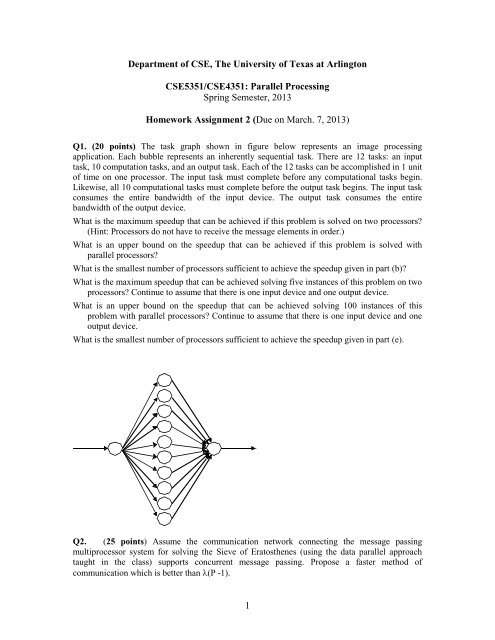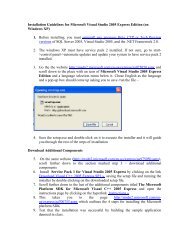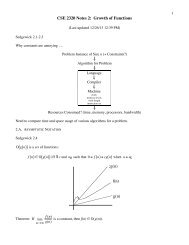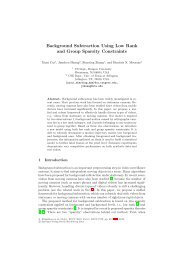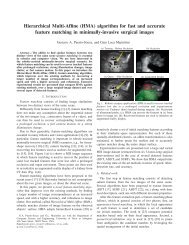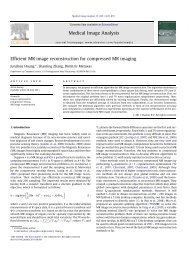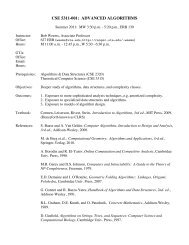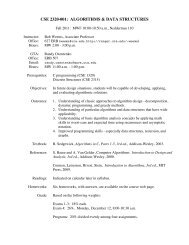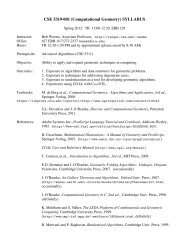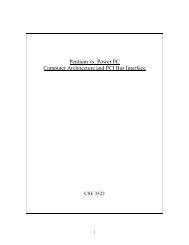Homework 2 - The University of Texas at Arlington
Homework 2 - The University of Texas at Arlington
Homework 2 - The University of Texas at Arlington
You also want an ePaper? Increase the reach of your titles
YUMPU automatically turns print PDFs into web optimized ePapers that Google loves.
Department <strong>of</strong> CSE, <strong>The</strong> <strong>University</strong> <strong>of</strong> <strong>Texas</strong> <strong>at</strong> <strong>Arlington</strong><br />
CSE5351/CSE4351: Parallel Processing<br />
Spring Semester, 2013<br />
<strong>Homework</strong> Assignment 2 (Due on March. 7, 2013)<br />
Q1. (20 points) <strong>The</strong> task graph shown in figure below represents an image processing<br />
applic<strong>at</strong>ion. Each bubble represents an inherently sequential task. <strong>The</strong>re are 12 tasks: an input<br />
task, 10 comput<strong>at</strong>ion tasks, and an output task. Each <strong>of</strong> the 12 tasks can be accomplished in 1 unit<br />
<strong>of</strong> time on one processor. <strong>The</strong> input task must complete before any comput<strong>at</strong>ional tasks begin.<br />
Likewise, all 10 comput<strong>at</strong>ional tasks must complete before the output task begins. <strong>The</strong> input task<br />
consumes the entire bandwidth <strong>of</strong> the input device. <strong>The</strong> output task consumes the entire<br />
bandwidth <strong>of</strong> the output device.<br />
Wh<strong>at</strong> is the maximum speedup th<strong>at</strong> can be achieved if this problem is solved on two processors?<br />
(Hint: Processors do not have to receive the message elements in order.)<br />
Wh<strong>at</strong> is an upper bound on the speedup th<strong>at</strong> can be achieved if this problem is solved with<br />
parallel processors?<br />
Wh<strong>at</strong> is the smallest number <strong>of</strong> processors sufficient to achieve the speedup given in part (b)?<br />
Wh<strong>at</strong> is the maximum speedup th<strong>at</strong> can be achieved solving five instances <strong>of</strong> this problem on two<br />
processors? Continue to assume th<strong>at</strong> there is one input device and one output device.<br />
Wh<strong>at</strong> is an upper bound on the speedup th<strong>at</strong> can be achieved solving 100 instances <strong>of</strong> this<br />
problem with parallel processors? Continue to assume th<strong>at</strong> there is one input device and one<br />
output device.<br />
Wh<strong>at</strong> is the smallest number <strong>of</strong> processors sufficient to achieve the speedup given in part (e).<br />
Q2. (25 points) Assume the communic<strong>at</strong>ion network connecting the message passing<br />
multiprocessor system for solving the Sieve <strong>of</strong> Er<strong>at</strong>osthenes (using the d<strong>at</strong>a parallel approach<br />
taught in the class) supports concurrent message passing. Propose a faster method <strong>of</strong><br />
communic<strong>at</strong>ion which is better than (P -1).<br />
1
(a) Describe the faster communic<strong>at</strong>ion algorithm (8)<br />
(b) Describe its time expression (8)<br />
(c) Analyze the execution time and speedup on 1, 2, 3, ...., 16 processors <strong>of</strong> the new Sieve<br />
algorithm th<strong>at</strong> will use your communic<strong>at</strong>ion scheme, assuming n = 1,000,000 and = 100X (10<br />
points).<br />
Q 3. (25 points) A sequential implement<strong>at</strong>ion <strong>of</strong> the Sieve <strong>of</strong> Earthosthenes marks about 2.2<br />
million cells in order to compute all primes less than 1 million. Estim<strong>at</strong>e the maximum speedup<br />
achievable by the control-parallel (shared memory) version <strong>of</strong> the Sieve <strong>of</strong> Er<strong>at</strong>hosthenes as it<br />
finds all the primes less than 1 million.<br />
Q 4. (25 points) Assuming a d<strong>at</strong>a-parallel approach on a distributed memory computer, calcul<strong>at</strong>e<br />
the speedup for n= 1,000,000 and = 100X. Repe<strong>at</strong> the same for = 1000X and = 10X.<br />
Calcul<strong>at</strong>e these speedups for 2, 3, 4, 5, .....16 processors and show the numbers in a table. Also<br />
draw a figure showing the three curves <strong>of</strong> speedup.<br />
SUBMISSION: WHAT, WHEN & HOW<br />
(1) Provide your answers on a word file.<br />
(2) This assignment is due on or before March 7, 2013<br />
(3) Use MS Word to cre<strong>at</strong>e your assignment and email it to the instructor iahmad@cse.uta.edu<br />
2


